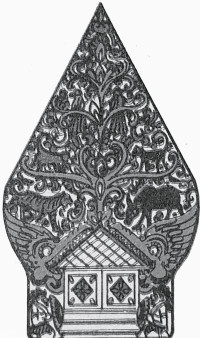Gunungan
Explore the ancient art form that dances in shadows and captivates hearts.
From Mountain to Canvas:

Drawing inspiration from the towering volcanoes of Indonesia, the gunungan depicts a mountain brimming with life. One side showcases a guarded palace gate, representing order, while the other portrays a blazing fire, symbolizing chaos and the underworld. This duality reflects the complexities of human existence.
Beyond Decoration:
The gunungan's significance goes beyond aesthetics. Before the performance, it stands tilted to the right, signifying the world waiting to unfold. As the story progresses, its position shifts to mark scene changes, acting as a silent narrator. It transforms into various settings like forests, roads, and even fiery infernos, guided by the puppeteer's (dalang) words.
A Legacy of Wisdom:
The gunungan comes in two variations: the Gunungan Gapuran, originating from the Demak Kingdom, and the Gunungan Blumbangan, created by Sunan Kalijaga. Both hold deep philosophical meaning, representing wisdom and the valuable lessons embedded within wayang performances.
More Than Just a Puppet:
The gunungan's versatility and symbolism transcend its physical form. It serves as a bridge between the audience and the story, reminding them of the larger themes woven into the performance. As the final act concludes, the gunungan finds its way back to the center, signifying the journey's end and leaving the audience with a lingering reflection on the world they just witnessed.
Last updated